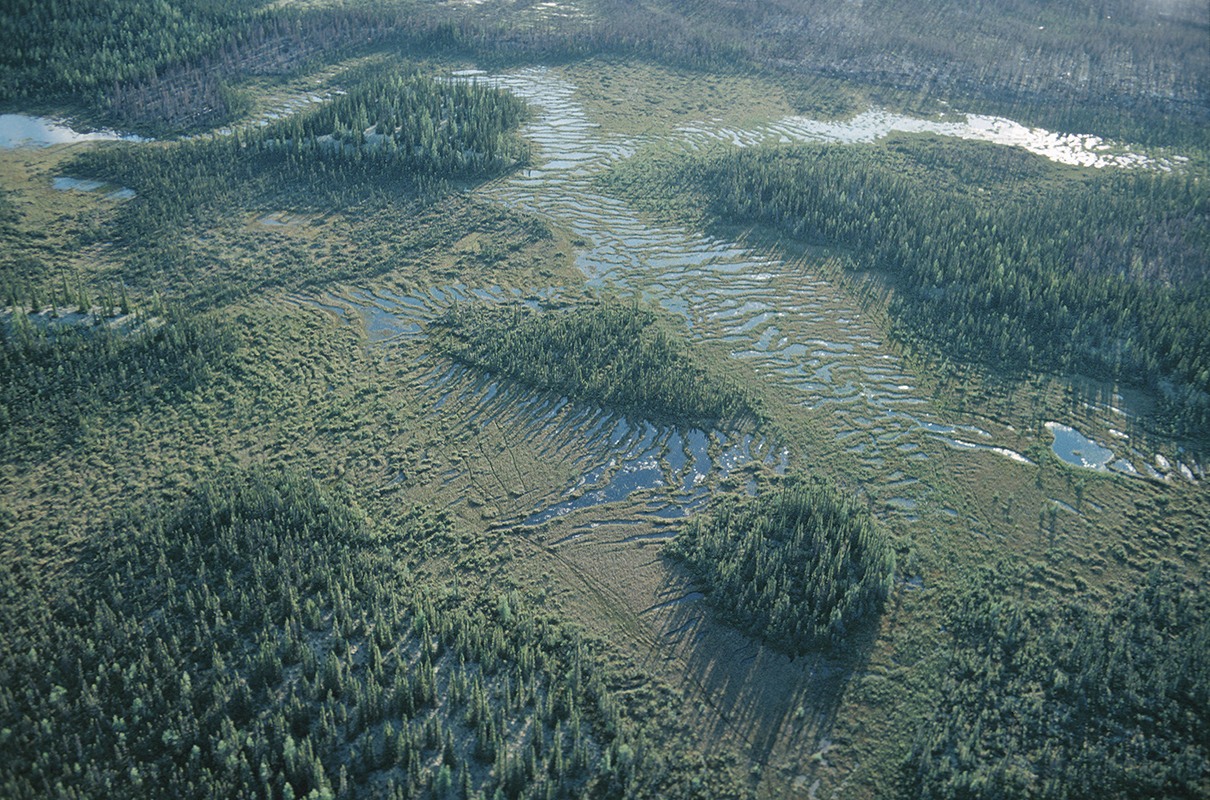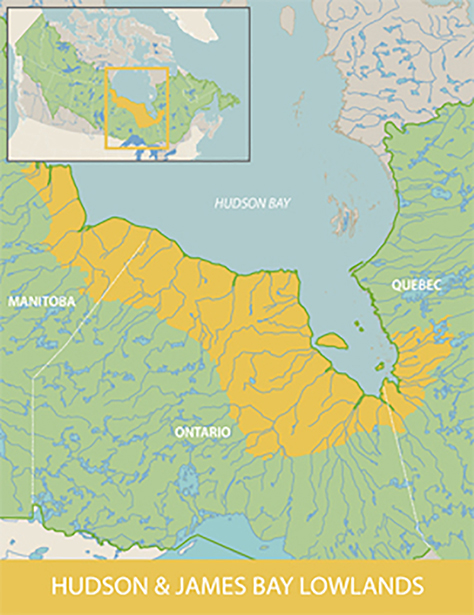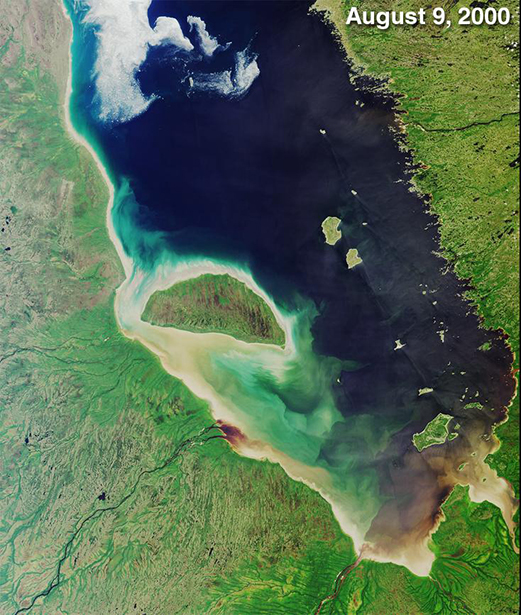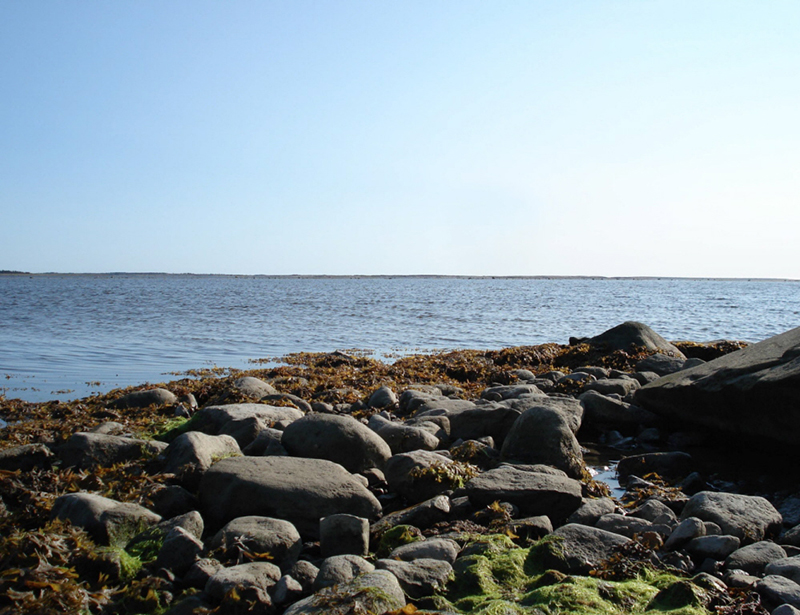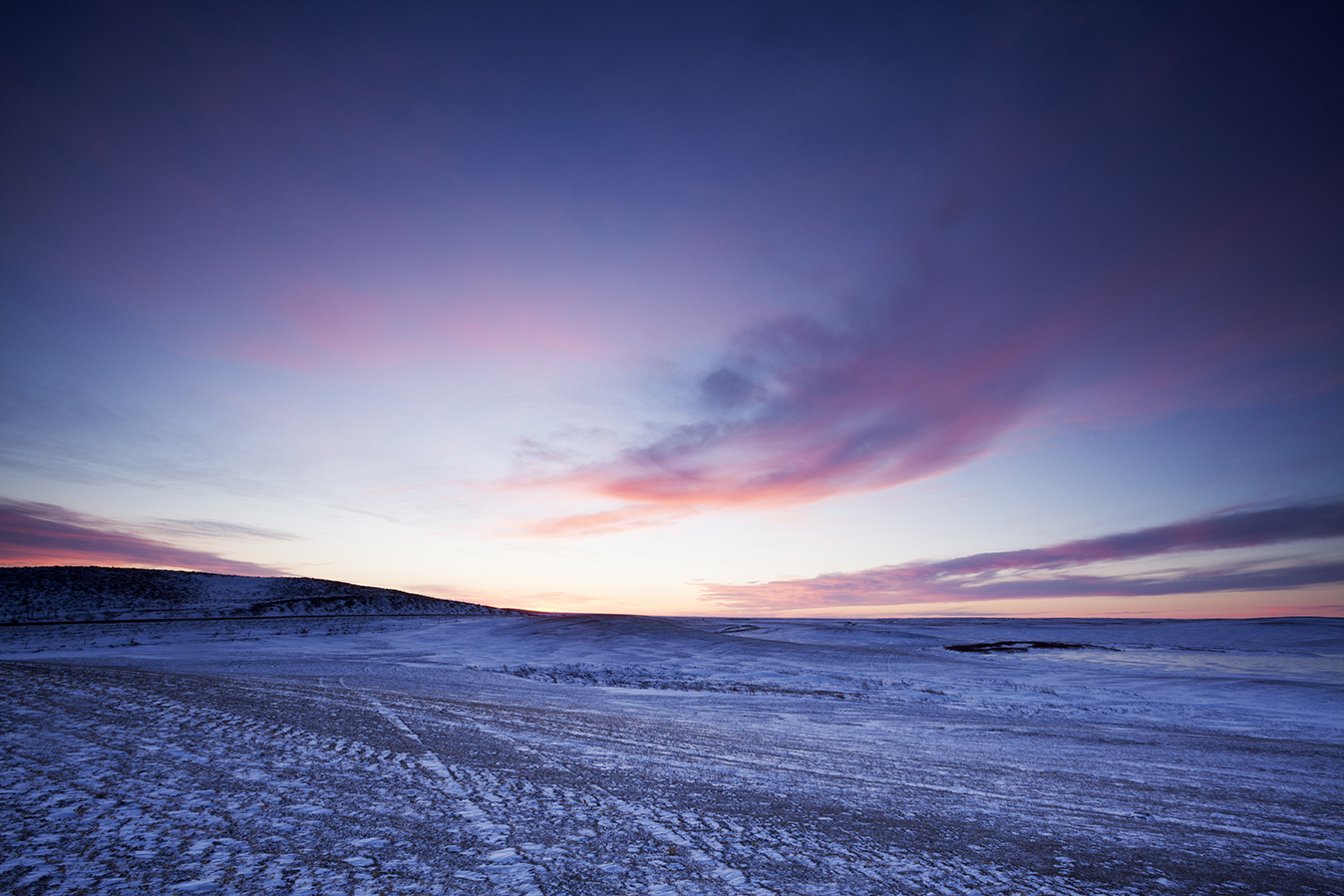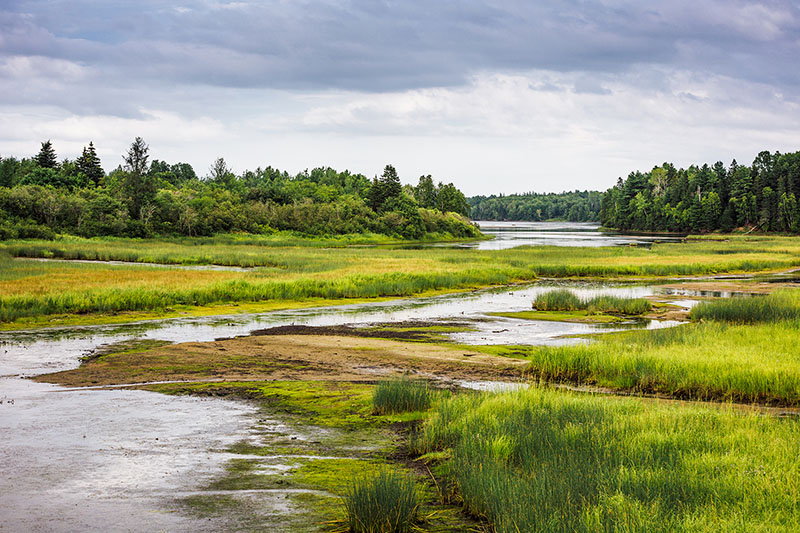Have you ever gone goose hunting? Do you know anyone who has? Goose hunting is a traditional activity for many of the Cree people living in the Hudson and James Bay region. Thousands of waterfowl, including geese and ducks, gather at the southern tip of James Bay during migration. The Hudson and James Bay Lowlands Wetland is a large area of marsh and swamp, the perfect environment for geese.
Why are we starting off the course talking about geese and marshes in the Hudson and James Bay Lowlands? Because this is an environmental science course and the biodiversity of the Hudson and James Bay Lowlands has a great deal to teach us about the risks to fragile habitats all around the world.
Notebook
This is a good time to introduce the unit 1 guided note-taking file. You can download and print it or, download and type into it as you work through the learning activities in this course. Using this file will help you organize your notes which in turn, will help you prepare for assessments and the final test.
Take a moment to organize your note-taking file (Opens in new window) now. You will receive a new guided note taking file for each unit.
Review the images below and consider - what features of the James Bay Lowlands Wetlands make it a good place for waterfowl? Make some rough notes about what features you think make this place an attractive place for waterfowl, specifically, ducks and geese. Add your notes to the appropriate section of your guided note-taking file.
In this learning activity, you will focus on different aspects of biodiversity, including the effect of human activity on different ecosystems.
Wetlands as ecosystems
Wetlands are areas where the land is saturated by water for all or part of the year. They are places where soil and water meet. A wide variety of grasses, plants, birds, insects, and animals live in wetlands. They are home to many different species and are considered the most diverse type of ecosystem.
An ecosystem is an area where all living (biotic) and non-living (abiotic) things interact together in a network. Biotic elements include humans, plants, animals, and insects. Abiotic elements are things like rocks, minerals, sun, soil, and water. All things in an ecosystem depend on each other. For example, many animals depend on other animals for food, and plants depend on the sun and earth for energy and nutrients.

Biodiversity
The more diverse an ecosystem, the more different types of animals, plants, and micro-organisms it has. Biodiversity is a measure of how many different types of living things are in an ecosystem. Higher levels of biodiversity lead to healthier ecosystems.
Biodiversity allows an ecosystem to survive such threats as bad weather, disease, or human activity. For example, a bird living in an area of great diversity may eat 30 different types of insects in addition to earthworms. In an ecosystem with very little biodiversity, there may be only five different types of insects to eat. If something were to damage the earthworm population, a bird that has 30 types of insects to eat would likely find plenty to feed on. On the other hand, a bird that has only five types of insects to eat could very well starve. Greater biodiversity allows ecosystems to bounce back and remain healthy in situations where part of the network is damaged.
Biodiversity is also important to humans, not only for the enjoyment of a variety of healthy ecosystems, but also because humans depend on a wide variety of plant, animal, and insect species. Look at corn as an example. There are many different types of corn. Each species of corn has a unique set of properties, including the following:
- growing time,
- colour,
- taste, and
- ideal environment.
These properties allow different types of corn to be grown in different environments all over the world.
Discover More
To extend your learning, you may choose to watch this short video to get a better understanding of what biodiversity means.
"What is Biodiversity" (Opens in new window)
This video link is provided as a suggestion only. You are encouraged to search for additional resources to support your understanding.
Hudson and James Bay Lowlands Wetland
The Hudson and James Bay Lowlands Wetland is in northern Ontario (about as far north as you can go in Ontario) along the coasts of the James and Hudson Bays.

This wetland is a large area of marsh and swamp with a high level of biodiversity. Within this diverse ecosystem are three internationally recognized and protected sites with wild populations of whales, caribou, geese, ducks, and polar bears. These animals depend on each other in a network that’s like a complicated web.
Using food webs to illustrate biodiversity
The connections between things in an ecosystem, and how each species depends on another to survive, are often illustrated using what’s called a food web. Learn more by reading "Wetlands mean life" (Opens in new window), which describes the food web in the Hudson Bay and James Bay Lowlands.
Take a closer look at the diagram of the foodweb.

This food web shows how plants in the Hudson and James Bay Lowlands ecosystem rely on the earth, the sun, and water to grow. These are not all the living things in this area, just a sample. If you follow the arrows away from the plant, you’ll see that animals, insects, and birds all rely on plants for their food. In turn, these animals, insects, and birds are eaten by other species.
Think about what would happen if something contaminated the water in this region. Imagine that the contaminant hurt or damaged the ninespine stickleback population. As you can see from the picture the ninespine stickleback is a very small fish, less than 5 cm in length.

What would happen if the ninespine stickleback fish were damaged?
If the ninespine sticleback fish population were damaged, the Arctic char, red fox, and sandhill crane would all lose a major food source. Depending on how many other things they had to eat, these populations could be seriously hurt.
Arctic char is also a fish that many humans love to eat. If the numbers of these fish dropped too low, humans would miss them as a source of healthy protein.
In the ecosystem, damage to one species affects not only those who eat it, but also the things that it usually eats. What about all the Invertebrates that would normally have been eaten by the ninespine stickleback? (Invertebrates are small animals without a backbone, such as insects.)
What would happen to the Invertebrate population without the ninespine stickleback fish?
Without the small fish to eat them, the Invertebrates could grow so large that they would begin to eat all the plant life in the area. This would ruin some plant populations that other species depend on.
As you can see, it is never possible to do only one thing to an ecosystem. Everything is interconnected and interdependent. Damaging just one population within an ecosystem affects everything else in it.
You might think that the James Bay coast is far from where you live, but many cities have protected wetlands as well. A good example of this is the Cootes Paradise area in Hamilton, Ontario. It’s a protected wetland area along the shores of Hamilton Harbour in Lake Ontario where waterfowl and fish breed and feed. Urban wetland areas like this are patches of biodiversity in cities with very little other wildlife.
Carrying capacity
You may have heard news reports about the problem of overpopulation in the world. This means that the human population has grown beyond its carrying capacity.
Definition
A population’s carrying capacity is the number of individuals the environment can sustain with food, water, and living space.
The lesser snow goose is an example of a species reaching its carrying capacity. An incredible four million lesser snow geese now gather in the marshes of the Hudson and James Bay Lowlands every spring and autumn.

The geese spend their winters in the south, where waste grain is left on farmers’ fields after the harvest. Farmers sometimes even flood the fields to attract waterfowl because their presence improves soil quality. Their feces and waste provide good fertilizer, and the water prevents soil from eroding or blowing away. The geese can easily eat this waste grain without any work and end up growing very strong and breeding more successfully. This has resulted in a huge increase in their population.
When the geese migrate north to the tundra (areas without farms), they rely on plant life for food. With a population so big, they damage fragile northern ecosystems by eating so many plants. This makes it difficult for other species to live there and affects the food web in many ways. It also means that the lesser snow goose has reached the carrying capacity of the tundra. The population is at a level where no more can be supported without running out of food in the summer.
Try it!
Check your understanding of some of the new terms and concepts introduced in this learning activity by completing the following tasks.
Part 1 - Fill in the blanks in the following sentence. Choose the best option for each black.
A [ _________1]’s carrying capacity is the [ _________2] of individuals that can be [ _________3] by the environment with [ _________4], [ _________5], and [ _________6].
Part 2 - Imagine one of the predator populations in the Hudson and James Bay Lowlands is reduced and the Arctic char population grows beyond its carrying capacity. How will other populations in the ecosystem be affected?

Please refer to this image for the next set of multiple choice questions.
Threats to biodiversity
There are many factors that threaten biodiversity by causing species to die off or disappear. They are caused by the ever-growing human population and its impact on the natural world.
Humans have affected almost every natural thing in the environment, which in turn has reduced biodiversity. People have polluted water, air, and soil around the globe. Efforts have often focused on progress, development, and technologies at the cost of the environment. Although attitudes toward the environment have begun to change, many of the problems created in the past remain. Select the tabs to learn about four major threats to biodiversity.
Sustainable versus renewable resources
Each of the four factors discussed before can decrease biodiversity, harming ecosystems. The impact on the environment is both damaging and disturbing. What can be done to reduce these threats?
One thing you can do to maintain the health of ecosystems is to use sustainable resources. A resource is sustainable if using it doesn’t hurt the environment and it doesn’t get used up. For example, using windmills to create power is sustainable because wind never gets used up. At the same time, it’s important to remember that everything you do affects the environment, even the use of windmills. For example, birds sometimes fly too close to windmills, get caught up in the air flow, and are hurt or killed by the spinning parts.
Another way to preserve the health of ecosystems is to use renewable resources. A resource is renewable if it can be used again. For example, if you harvest trees (log) properly by replanting, there will be new tree growth that can be harvested again in about 30 years. Many industries are using cork trees and bamboo plants instead of hardwood trees because they grow back in 5 to 10 years instead of 30. These plants are used to make cork flooring, bamboo flooring, and bamboo furniture and even bamboo fabric.
Using sustainable and renewable resources helps preserve the health of ecosystems by reducing negative impact by humans on biodiversity.
Many industries can have a negative impact on the environment. As you’ll discover in the next section, one of them is travel and tourism.
Ecotourism
In 2018, according to Statistics Canada, the Canadian tourism industry generated more than $80 billion in revenue. Can you imagine the impact that much tourism could have on the environment? Tourism and travel are linked to a lot of vehicle emissions, airplane exhaust, and oil from boats leaking into lakes. Resorts and hotels are often built in prime environmental locations, thus destroying the natural environment. Harsh chemicals are used to clean washrooms, floors, and bedsheets in hotels. These things can add up to produce a big impact on the environment.

Ecotourism is a new trend in tourism that focuses on respecting both the environment and the local culture. Using methods of travel that have a minimal impact on the environment, tourists go to natural areas and appreciate the local culture.
Costa Rica is one country where ecotourism is thriving. Environmentally friendly resorts and guides offer insight into local culture as well as low-impact activities such as kayaking, biking, horseback riding, and zip-lining. All these activities are great ways to appreciate nature.
Sometimes ecotourism actually involves volunteering to help with ecosystem restoration or supporting species at risk. Consider this video describing a form of ecotourism involving volunteer work.
Watch This!
Watch "Ecotourism in Costa Rica"
Costa Rica is a small developing country with a wide variety of ecosystems, including beaches, rainforest, and volcanoes. All these ecosystems have plenty of biodiversity and wildlife. Costa Rica has invested in developing ecotourism as a major industry. From an environmental point of view, though, ecotourism can have both positive and negative impacts.
On the negative side, any tourism brings with it increased emissions from planes and vehicles. Added to this substantial source of pollution are other impacts on the environment, such as increased foot traffic in natural areas and the production of waste. Waste comes in the form of human waste (feces, urine), food waste, packaging from the products consumed, and chemical waste from cleaning processes.
Ecotourism can be seen in a positive light because it brings in enough income that natural land doesn’t have to be sacrificed to industries that might build large factories or other developments. At the same time, ecotourism encourages small-scale, environmentally friendly building in areas developed for tourism. Unlike the large hotels and buildings of traditional tourism, these small establishments allow tourists to experience local culture. Ecotourism also encourages small conservation initiatives like fundraising to support rainforest conservation. When tourists return from their eco-vacations, many decide to help the environment they visited either by returning to support current conservation programs in the country or to start new initiatives with funds they’ve raised.
Costa Rica has done a good job of regulating its ecotourism industry and balancing the need for income (money) with the need for ecosystem health. It’s a delicate balancing act to enforce all the environmental laws and still generate profit.
To further your understanding about the impact of ecotourism on Costa Rica, read this article entitled "Ecotourism Costa Rica" (Opens in new window) that explores the impact on the guides who work in the industry.
Many countries and organizations struggle with the same balancing act. It’s always important to look at the environmental impact of activities you choose to participate in.
Evaluating leisure and tourism activities
Bear hunting, a sport in Northern Ontario for some, a way of life for others, is another example of the balancing act between economics and ecosystem damage. In Ontario, the Ministry of Natural Resources (MNR) regulates hunting and fishing. For years, bear hunting was allowed twice a year, once in the fall and once in the spring, but it has some fairly obvious negative impacts on the environment. For example, it leads to increased emissions from vehicles. In 1999, MNR ended the spring bear hunt. Since the spring hunt was cancelled, however, some people living in northern Ontario have complained that the bear population has grown too large and has been causing a variety of problems.
To analyze the impact of bear hunting, we must consider both negative and positive impacts on the environment, as well as how bear hunting can become more environmentally friendly. Select the tabs to learn more.
As you can see, even recreational activities that seem to have a negative impact on the environment can have some positive effects. On the flip side, activities that have obvious benefits for the environment can have negative effects as well. The bottom line is that it’s important to evaluate the impact of leisure and tourism activities, and to make those activities as environmentally friendly as possible.
Task: Assessing impacts of tourism
Many people in Ontario enjoy spending time at cottages or resorts throughout the summer months. Among the most popular activities on Ontario’s lakes are waterskiing and wakeboarding. Wakeboarding is like snowboarding on water. Participants ride a board behind a motorboat, jumping and doing tricks off the boat’s wake. The sport is becoming so popular that communities are competing to host Wakestock, an annual wakeboarding competition. It attracts many fans and tourists, so communities want to host the festival to make money.
Notebook
Create a table like the one below in your notebook and list the ways that wakeboarding will have a negative impact on the environment. Then list the things that can be done to make this recreational activity “greener” or better for the environment. Check your answers against the suggested answers once finished.
(Note: This table has only two columns because there are no environmental benefits associated with wakeboarding.)

